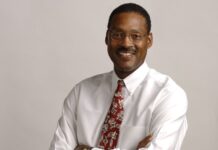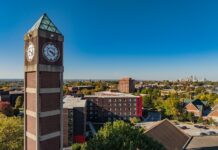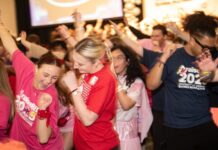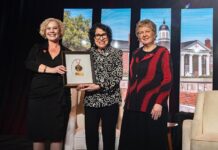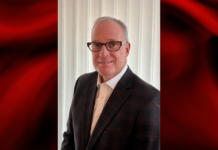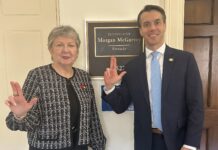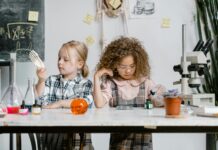Not all studies take place in the lab, and not all scientists wear lab coats. At the University of Louisville, researchers work out in the field, shoulder-to-shoulder with community members, to understand and solve problems that affect their shared home.
Through community-engaged research, the city becomes a sort of ‘living, urban lab,’ allowing researchers to collaborate with their neighbors on important issues such as health, economic development, education and more.
It’s a special focus for UofL, one of only 84 universities nationwide to hold both the top-tier Research 1 and Community Engaged designations through the Carnegie Classifi cation of Institutions of Higher Education. The goal is to improve the quality of research by talking to people who know the problem best — because they live it — to create mutual benefit and positive impact.
“We have to work together to create that road map, agree on the kinds of questions that we’re trying to answer and have a shared understanding of the challenges,” said Ted Smith, associate professor in the School of Medicine and director of the UofL Center for Healthy Air, Water and Soil within UofL’s Christina Lee Brown Envirome Institute. “We’ve had projects where everybody could be involved in the science and I think Louisville is particularly good at this; we’re curious people and there is a service mentality.”
Smith is one of many at UofL conducting community-engaged research. All across campus, researchers are partnering with the community to make discoveries about the environment, equity, aging, workforce development and more. Douglas Craddock, Jr., UofL’s vice president for community engagement, said that while community-engaged research has direct tangible benefit here, what we learn from it can have a positive impact far beyond.
“It’s important that the community is involved in the research,” said Craddock, whose office works broadly with local organizations to build and sustain community relationships and trust. “Not just simply involved, but impacted by the research in the way that changes lives for years to come.”
Here are just a few ways UofL researchers are making meaningful impact by working with the community.
PLANTING A SEED
They say you should stop and smell the roses. But what if you look around your neighborhood, and there are no roses … or any plants at all?
Scientists can make educated guesses about what kind of impact a neighborhood’s greenness — or lack thereof — might have on the people living there, including on physical, mental and emotional health. But to really know, you have to go meet your neighbors, roll up your sleeves and get your hands a little dirty. So, that’s exactly what UofL researchers did.

In an effort known as Project Green Heart, the UofL Envirome Institute led the planting of thousands of trees and shrubs across South Louisville as part of a first-of-its-kind interventional study on how greenness effects health outcomes. Neighbors picked up shovels, filled out surveys and worked with the researchers to study and improve their community.
“It was great to see the trees planted in my neighborhood,” said Toni Smith, who lives in an area covered by Project Green Heart. “Not only did they provide screens from pollution, they offered privacy and helped to beautify our homes. As a participant in the study from the beginning, I am excited about the research on our neighborhood air pollution.”
As the first large-scale interventional clinical trial of this kind, this study will have significant value as cities around the world seek to mitigate the health risks from a changing climate though green infrastructure. The results could also reveal new public health approaches to improving heart, psychological and other health outcomes.
Working with the community can take some of the guesswork out of research and ensure it has real-world impact, said Luz Huntington Moskos, director of the community-engagement core in the Envirome Institute’s Center for Integrative Environmental Health Sciences. As a result, community engagement is required by many of the National Institute of Health’s largest grant programs, including ones supporting projects through Envirome.
“We, as scientists, can have very educated guesses about what’s happening,” she said, “but really understanding how people are impacted in their daily lives and the priorities of the community members is very important.”
GETTING TO WORK
We rely on technology for everything these days — to keep us connected, to find our way and even to make our morning cup of coffee. But technology has also had a deep and lasting impact on the way we work, with many jobs now requiring an entirely new skillset than even just a decade ago.
“How do you — as a member of the workforce, an employer or a student — prepare for these changes?” said Jeff Sun, a professor and dean of research in the UofL College of Education and Human Development. “That’s the question for a number of industries.”
Sun and UofL teammates Annika Bennett and D’Neika Lopez are working to better understand these changes through their U.S. Department of Labor-funded Modern Apprenticeship Pathways to Success (MAPS) program. They’ve also enlisted community partners, including Louisville’s newly created WestEnd Apprenticeship Collaborative, the Kentucky Primary Care Association and eastern Ky.-based Mountain Comprehensive Health Corporation (MCHC).
The idea is to study this evolving ‘future of work’ in different settings and industries, each with its own unique workforce needs. In health care, for example, the providers of tomorrow are expected to work with new tools like AI-driven diagnostics and electronic medical records systems. Teresa Dotson, director of financial affairs at MCHC, said the research done with UofL – and resulting training – has helped fill the system’s talent pipeline while preparing people for jobs they might not have otherwise had.
“This is my community, and I believe that life shouldn’t be a barrier to education or a career,” said Teresa Dotson, director of financial affairs at MCHC. “I can honestly say that this is my favorite project I’ve ever worked on in my career.”
Ultimately, the researchers hope to create industry-specific training and apprenticeships that connect what students learn in class with their eventual careers. The apprenticeships will also give them field experience with disruptive, cutting-edge technologies that can change how work is done.
Sun said preparing a future tech-ready workforce is especially important now. According to a 2019 report from the Brookings Institute, automation will be most disruptive in the Heartland, and especially in Kentucky and Indiana, with hundreds of thousands of jobs susceptible to automation. Meanwhile, new jobs will be created and others will evolve to require new tech skills.
“It’s absolutely critical that we’re ready for the workforce needs of tomorrow,” he said. “By partnering with the employers and workers who see those needs in the real world, we can better predict and prepare for them.”
BREAKING DOWN BARRIERS
Thump. Thump. Your heart is racing, and you feel a sharp pain pierce your chest. You need help, but can’t go to the hospital. You never applied for insurance — well, you tried, but the forms were confusing and in a language you don’t understand.

“A lot of our first-generation immigrant neighbors, especially aging Asian immigrants, face barriers like this in accessing health care,” said Dee Antimisiaris, an associate professor in UofL’s School of Public Health and Information Sciences. “If you don’t know the culture, language and the complex U.S. health care system, it’s going to be incredibly difficult to navigate.”
But you can’t really understand those difficulties unless you’ve experienced them. So, Antimisiaris and researchers from UofL’s Kent School of Social Work teamed up with Louisville’s Asia Institute Crane House, a non-profit organization working to expand understanding between the peoples of Asia and the U.S.
Together, they held focus groups with health care providers, aging Asian American immigrants and their children, who often act as translators, navigators, social workers and advocates when their parents seek care. Kiran Kaur, a first–generation Punjabi, Sikh immigrant who participated in the study with her parents, said it felt empowering to work with researchers on problems that affect the people she cares about.
“Working on an initiative that centered toward Asian health was able to give me an additional voice that helped share the seriousness of health to my Asian family, friends and community,” said Kaur, a pharmacy technician. “This type of work contributes to the foundation of creating a future for the Asian generations to come.”
The problem is not only complex, but growing. According to the Pew Research Center, Asian American is the fastest-growing ethnic or racial group in the U.S., representing some 22 million people — 57 percent of which are first–generation immigrants. They come from more than 20 countries, each of which has its own culture, history, language and relationship with health and health care. That is, there’s no one-size-fits-all solution.
The researchers now are working to disseminate their findings and explore ways to best reach and support the diverse members of this community. Currently, backed by a Humana Foundation Community Partners Grant, they’re piloting a volunteer, peer-to-peer support program and partnering with UofL’s J.B. Speed School of Engineering to build a digital tool for immigrants struggling to navigate the U.S. health care system.
“Community-engaged research is critical to helping us understand the unique and complex needs of this diverse community,” Antimisiaris said. “As communities grow and become more global, the way we do research and implement care and policy must modernize accordingly. Without community engaged research, we can only guess about how to meet population health needs.”
Betty Coffman in the Office of Communications & Marketing contributed to this article.












